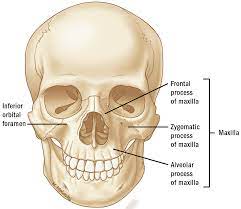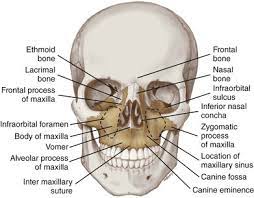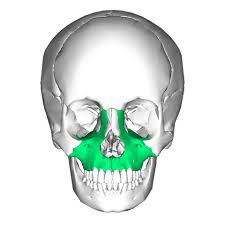


The maxilla is the upper fixed bone of the jaw formed from the fusion of two maxillary bones.
The upper jaw includes the hard palate in the front of the mouth.
The two maxillary bones are fused at the intermaxillary suture, forming the anterior nasal spine.
The mandible is also a fusion of two mandibular bones at the mandibular symphysis, and is the movable part of the jaw.
Then maxilla consists of:
The body of the maxilla
Four processes:
the zygomatic process
the frontal process of maxilla
the alveolar process
the palatine process
three surfaces – anterior, posterior, medial
the Infraorbital foramen
the maxillary sinus
the incisive foramen
Each maxilla articulates with nine bones:
two of the cranium: the frontal and ethmoid
seven of the face: the nasal, zygomatic, lacrimal, inferior nasal concha, palatine, vomer, and the adjacent fused maxilla.
Sometimes the maxilla articulates with the orbital surface, and sometimes with the lateral pterygoid plate of the sphenoid.
The maxillary sinus presents the appearance of a furrow on the lateral wall of the nose.
The alveolar process of the maxilla holds the upper teeth, and is referred to as the maxillary arch.
Each maxilla attaches laterally to the zygomatic bones, or cheek bones.
Each maxilla assists in forming the boundaries of three cavities:
the roof of the mouth
the floor and lateral wall of the nasal cavity
the wall of the orbit
Each maxilla also enters into the formation of two fossae: the infratemporal and pterygopalatine, and two fissures, the inferior orbital and pterygomaxillary.
A maxilla fracture is a form of facial fracture.
A maxilla fracture is often the result of facial trauma such as violence, falls or automobile accidents.
